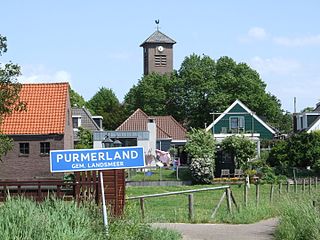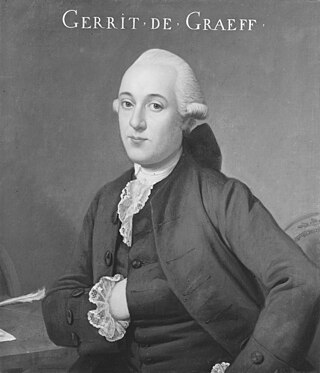
Ilpendam is a village in the province of North Holland, Netherlands. It is a part of the municipality of Waterland, and lies about 4 km south of Purmerend. It covers an area of 2.46 km2 and had 1,780 inhabitants in 2008. Ilpendam was part of the Free and high Lordship of Purmerend, Purmerland and Ilpendam.

Frans Banninck Cocq, free lord of Purmerland and Ilpendam was a knight, burgemeester (mayor) and military person of Amsterdam in the mid-17th century, the Dutch Golden Age. He belonged to the wealthy and powerful Dutch patriciate, the regenten, and is best known as the central figure in Rembrandt's masterpiece The Night Watch.

Purmerland is a village of 395 in the municipality of Landsmeer, North Holland, the Netherlands. It is located just north of Den Ilp and just south of the housing estate of Weidevenne, part of the city of Purmerend. It is directly connected to both of these as Purmerland, like Den Ilp and Landsmeer is mainly characterised by ribbon building along the main road. Purmerland was part of the Free and high Lordship of Purmerend, Purmerland and Ilpendam.

Cornelis de Graeff, often named Polsbroek or de heer van (lord) Polsbroek during his lifetime, was an influential regent and burgomaster (mayor) of Amsterdam, statesman and diplomat of Holland and the Republic of the United Netherlands at the height of the Dutch Golden Age.

Catharina Pietersdr Hooft was a woman of the Dutch Golden Age. She became famous at a very early age, when she was painted by Frans Hals.

De Graeff is a Dutch noble family.

Dirck Jansz Graeff, also Diederik Jansz Graeff, Lord of the manors Valckeveen and Vredenhof, was a patrician, wholesaler, shipowner, politician and large landowner. He became an important figure of the Protestant Reformation, member of the Reformed Church, supporter of the Geuzen and the Protestant-minded community of wholesale merchants, and a confidant of William I of Orange. Graeff was the founder of a regent dynasty of the Dutch Golden Age and the short time of the First Stadtholderless Period that retained power and influence for centuries and produced a number of ministers. He was the first Burgomaster of Amsterdam from the De Graeff family.

Pieter de Graeff was a Dutch aristocrat of the Dutch Golden Age and one of the most influential pro-state, republican Amsterdam Regents during the late 1660s and the early 1670s before the Rampjaar 1672. As president-bewindhebber of the Dutch East India Company, he was one of the most important representatives and leaders of the same after the Rampjaar.

Johan de Graeff, also Jan de Graeff - patrician of Amsterdam, Free Lord of Zuid-Polsbroek - was a member of the De Graeff - family from the Dutch Golden Age. His political Position was that of the Dutch States Party.

Gerrit de Graeff belonged to the patrician class of Amsterdam and held the feudal titles Free Lord of Zuid-Polsbroek as those of 21st Purmerland and Ilpendam. Known for his wealth and notorious for his stinginess, De Graeff was not particularly popular.

Gerrit de Graeff, vrijheer van Zuid-Polsbroek, Purmerland and Ilpendam was a member of the influential De Graeff family of Amsterdam. He belonged to the patrician class of the city and held the feudal titles Free Lord of Zuid-Polsbroek as those of Purmerland and Ilpendam.

Cornelis de Graeff was a member of the family De Graeff, a prominent regent family from the Dutch Golden Age. He held the title 20th Free Lord of Purmerland and Ilpendam.

The Free or high Lordship of Purmerend and Purmerland and after 1618 Purmerland and Ilpendam was a type of local jurisdiction with many rights.

Jacob de Graeff was a member of the De Graeff-family from the Dutch Golden Age. He was an Amsterdam regent and held the title as 20th Free Lord of Ilpendam and Purmerland.

Volkert Overlander was a Dutch noble, jurist, ship-owner, merchant and an Amsterdam regent from the Dutch Golden Age.

Maria Overlander van Purmerland was a noble from the Dutch Golden Age and Free Lady of Purmerland and Ilpendam. She was married to Frans Banninck Cocq, who was the captain of the 1642 painting The Night Watch by Rembrandt.

Gerrit de Graeff (II) van Zuid-Polsbroek was a Dutch politician at local and national Level during the Patriottentijd and afterwards. He belonged to the patrician class of Amsterdam and held the feudal titles Free Lord of Zuid-Polsbroek as those of Purmerland and Ilpendam.

Jan Pietersz Graeff was an Amsterdam regent and cloth wholesaler from the 16th century.
Gerrit de Graeff (IV), vrijheer van Zuid-Polsbroek, Purmerland and Ilpendam (26 July 1797, Ilpendam – 27 March 1870) was a Dutch patrician, Amsterdam aristocrat and feudal Lord.

Jacoba Bicker was from the Bicker family, which was one of the leading pro-state families in the Dutch Golden Age.





















